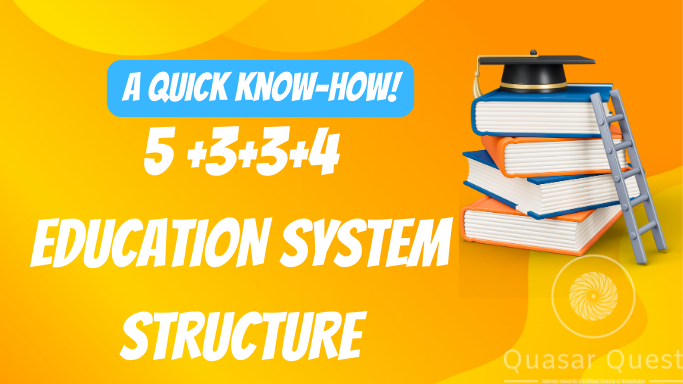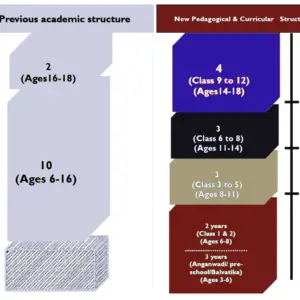
About NEP 2020
5 3 3 4 Education System Structure, The National Education Policy (NEP) 2020 is an all-encompassing framework devised by the Government of India to revamp the education system of the country.
The objective is to tackle the diverse obstacles encountered by the current system and harmonise India’s educational methods with international benchmarks, while also accommodating the distinct requirements of the country.
The NEP 2020 incorporates a multitude of changes and programmes that span across all educational levels, ranging from early childhood to higher education.
The 5 3 3 4 Education System Structure, launched by the National Education Policy (NEP) 2020, is a groundbreaking and revolutionary educational framework. This framework transforms the conventional approach to education by structuring it into four independent stages, adapted for age groups and learning needs.

New Academic Structure of (5 3 3 4) education system structure
Foundational Stage (5 Years): Focuses on play-based learning for ages 3-8.
Preparatory Stage (3 Years): Emphasizes language and numeracy skills for ages 8-11.
Middle Stage (3 Years): Introduces abstract concepts across subjects for ages 11-14.
Secondary Stage (4 Years): Offers multidisciplinary education and subject choice for ages 14-18.
Let us delve deeper into each stage of the 5 3 3 4 education System structure as given in the National Education Policy (NEP) 2020:
5 3 3 4 Education System Structure: The Foundational Stage (five years)
- This stage lasts for five years and is essential for establishing a foundation for a child’s educational path.
- Preschool or Anganwadi education, which runs for three years and is aimed at children between the ages of three and six, is the first step.
- During this period, the emphasis is placed on learning strategies that are centred on play and activities, with the goal of fostering the development of foundational skills within the areas of language, numeracy, social interaction, and cognitive capacities.
- After completing their preschool education, children typically move on to classes 1 and 2, where they continue to develop these core abilities within the context of a classroom setting that is more regimented.
5 3 3 4 Education System Structure: The Preparatory Stage (three years)
- The preparatory stage continues for three years, from classes three to five, and is designed for children who are between the ages of eight and eleven years old.
- During the preparatory stage, the goal is to further enhance literacy, numeracy, and other critical academic skills. This is accomplished by building upon the foundational skills that were obtained during the preceding stage.
- It gives students a period of transition during which they may adjust to learning environments that are more regimented, and it also helps them get ready for the academic challenges that they will face throughout the middle stage.
5 3 3 4 Education System Structure: The middle stage (three years)
- The middle stage, which lasts for three years and spans classes six through eight, is aimed at pupils who are between the ages of eleven and fourteen.
- During this stage, students are presented with more abstract ideas and are given the opportunity to go into greater depth about a variety of areas, including as mathematics, the sciences, the social sciences, the arts, and the humanities.
- Students are given the opportunity to engage with real-world applications of their knowledge and build abilities in critical thinking and problem-solving using experiential learning methodologies, which are prominent in this curriculum.
5 3 3 4 Education System Structure: The Secondary Stage (four years)
- The Secondary stage, which lasts for four years, is comprised of classes 9 through 12 and is designed for students who are between the ages of 14 and 18 years old.
- The secondary stage prepares students for higher education or entry into the workforce by providing comprehensive learning experiences and opportunities for personal and intellectual growth.
- It offers a multidisciplinary education with a focus on flexibility and choice of subjects, allowing students to explore their interests and aptitudes.
- It allows students to explore their interests and aptitudes.
Conclusion
A developmental approach to education is reflected in the overall structure of the 5 3 3 4 education system. Each step of the structure is designed to fulfil the ever-changing requirements and talents of students who are in different age groups. The aim of this programme is to provide students with an educational experience that is more comprehensive and inclusive, with the goal of providing them with the knowledge, skills, and competencies necessary for success in the 21st century.
Reference: https://www.education.gov.in/national-education-policy

Pingback: NEP 2020: Decoding India's New National Education Policy - Quasar Quest